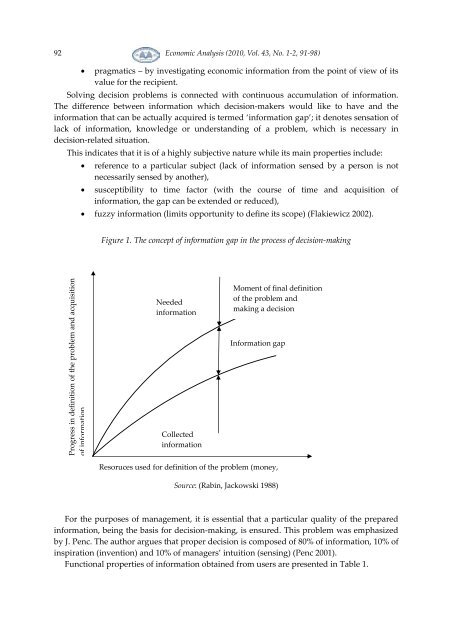Twice a Year Scientific Journal
Twice a Year Scientific Journal
Twice a Year Scientific Journal
You also want an ePaper? Increase the reach of your titles
YUMPU automatically turns print PDFs into web optimized ePapers that Google loves.
92<br />
Economic Analysis (2010, Vol. 43, No. 1-2, 91-98)<br />
• pragmatics – by investigating economic information from the point of view of its<br />
value for the recipient.<br />
Solving decision problems is connected with continuous accumulation of information.<br />
The difference between information which decision-makers would like to have and the<br />
information that can be actually acquired is termed ‘information gap’; it denotes sensation of<br />
lack of information, knowledge or understanding of a problem, which is necessary in<br />
decision-related situation.<br />
This indicates that it is of a highly subjective nature while its main properties include:<br />
• reference to a particular subject (lack of information sensed by a person is not<br />
necessarily sensed by another),<br />
• susceptibility to time factor (with the course of time and acquisition of<br />
information, the gap can be extended or reduced),<br />
• fuzzy information (limits opportunity to define its scope) (Flakiewicz 2002).<br />
Figure 1. The concept of information gap in the process of decision-making<br />
Progress in definition of the problem and acquisition<br />
of information<br />
Needed<br />
information<br />
Collected<br />
information<br />
Moment of final definition<br />
of the problem and<br />
making a decision<br />
Information gap<br />
Resoruces used for definition of the problem (money,<br />
Source: (Rabin, Jackowski 1988)<br />
For the purposes of management, it is essential that a particular quality of the prepared<br />
information, being the basis for decision-making, is ensured. This problem was emphasized<br />
by J. Penc. The author argues that proper decision is composed of 80% of information, 10% of<br />
inspiration (invention) and 10% of managers’ intuition (sensing) (Penc 2001).<br />
Functional properties of information obtained from users are presented in Table 1.
















